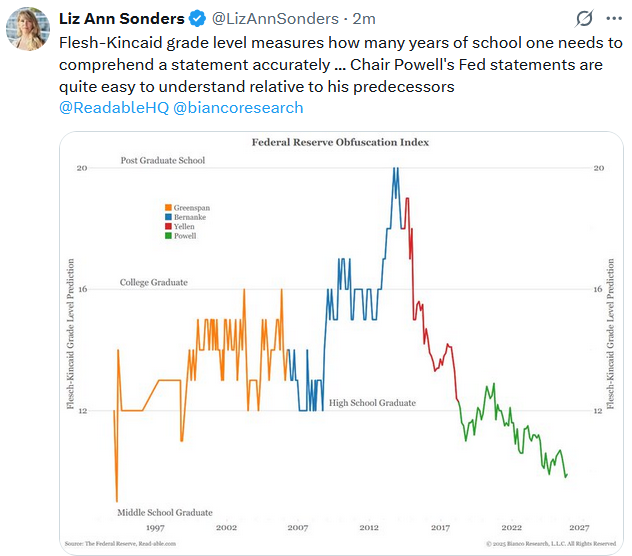Gold prices slip as stronger dollar, Fed rate uncertainty weigh
Last Wednesday, for the first time since November 2021, a Hindenburg Omen hit. This gauge is triggered when an upward trend is met with a growing number of stocks hitting both new 52-week highs and lows. Such indicates bad breadth, weakening momentum, and indecision.
If all five conditions listed below are met, the indicator gives a yellow signal. If such an occurrence happens twice within 36 days, a Hindenburg Omen is triggered:
- Uptrend: The 50-day moving average of the NYSE Composite Index is above its 10-day moving average.
- New Highs Expansion: At least 2.2% of NYSE stocks hit new 52-week highs
- New Lows Expansion: At least 2.2% of NYSE stocks hit new 52-week lows
- Breadth Threshold: The lesser of new highs or new lows must exceed 2.8% of total NYSE issues.
- Momentum Break: The McClellan Oscillator (a breadth momentum tool) must turn negative.
The graph shows that over the last eight years, not all Hindenburg Omens (red) resulted in significant drawdowns; however, an Omen accurately preceded the steep pandemic decline in 2020. While not shown, the Hindenburg Omen effectively warned of the twin peaks before the 2008 Financial Crisis and the Dotcom bubble top.
The analysis shown is on the NYSE Composite Index. Sentiment trader runs the same analysis on the S&P 500 and Nasdaq and finds that Omens become more concerning when a large cluster of signals forms over a short period. Their website notes that both the S&P 500 and the Nasdaq triggered a Hindenburg Omen last week.
Bottom line: market breadth is horrendous and will likely lead to a rotation favoring out-of-favor sectors and stocks. Thus, it’s not surprising that the Hindenburg Omen was triggered. If we continue to see more of these Omens, the threat of a drawdown grows.

The Week Ahead
After a lull in economic data, we get the ISM manufacturing and services surveys and the ADP labor report this week. The ISM surveys not only provide a broad economic sentiment reading but also break it down into subcomponents. Many investors will key on new orders as a gauge of future economic activity, along with prices and employment data.
As we noted last week, ADP will now report its job gain/loss data weekly. Thus, after last week’s report of a 14k-job gain for the month ending October 11, we should expect a similar reading. However, this report will be its monthly report, which includes more details than its new weekly report.
The number of daily earnings reports will die down this week, but there are still a few important ones to follow. Included in this list are:
- Monday: Palantir (NASDAQ:PLTR) and Williams
- Tuesday: AMD (NASDAQ:AMD)
- Wednesday: McDonald’s (NYSE:MCD) and Qualcomm (NASDAQ:QCOM)
- Friday: Duke Energy (NYSE:DUK)
The Fed will be active on the speaking circuit and will hopefully provide more details on why they ended QT and their perceived monetary policy path ahead.
Gold Myths Luring Investors Into Risk
In case you haven’t heard, precious metals, particularly gold, have risen sharply this year. Of course, whenever any asset class experiences a more speculative melt-up, investors are quick to rationalize why “this time is different.” In stocks, it is about “artificial intelligence” and “data centers.”
The cryptocurrency community believes all fiat currencies will fail and everything will move to the digital asset. But when it comes to gold, the voices have grown loudly, claiming the reasons for the rise are debasement of the dollar, de-dollarization, and soaring debt levels.
For example, Bloomberg lumped all three worries into one article.
“Beneath the surface of the short-term ups and downs of financial markets, a longer-term repricing of multiple assets may be underway as investors seek to protect themselves from the threats posed by runaway budget deficits.
Those who believe in it are pulling away from sovereign debt and the currencies they are denominated in, fearful their value will be eroded over time as governments avoid tackling their massive debt burdens and even seek to add to them.Further fuel is coming from speculation that central banks will face increasing political pressure to hold down interest rates to offset what governments owe — and in the process fan inflation by continuing to crank out cash.“
The problem with the Bloomberg article is that it was unresearched and just a recycling of already prevalent myths. In this article, we will go through each gold myth and present the data behind the analysis.
Tweet of the Day

